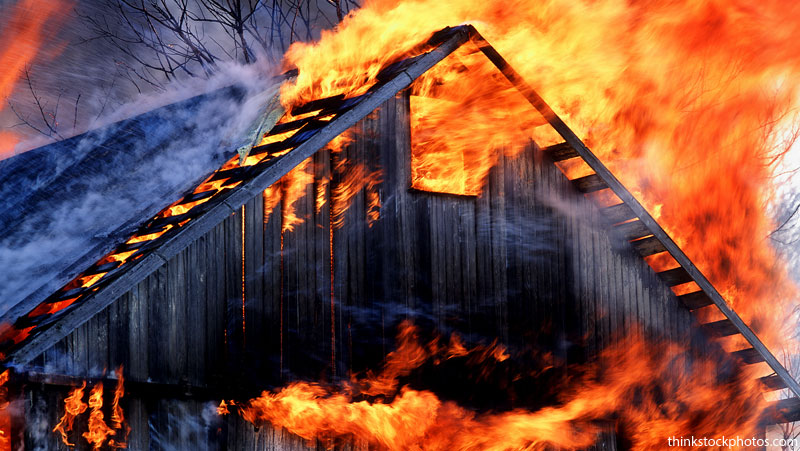
Whenever we hear about someone’s barn going up in flames, we tend to soothe ourselves with thoughts that it is improbable that our property would suffer the same fate. Someone was probably smoking, we might think, or their electrical wiring was old and unsafe. It will never happen to me.
How Fire Works
Fire is a chemical reaction that needs three things to get going and to survive: oxygen, fuel and heat (referred to as the “fire triangle” by fire experts). And horse barns have these things in spades. Barns have good ventilation to allow influx of healthy air (oxygen), they are wired with electricity for lighting and heating equipment, and, of course, barns are filled with hay and other flammables, from medical treatments to tractor fuel. Take away any side of the triangle and a fire won’t be able to occur.
Cleanliness
Robert says everyone should keep safety at the forefront by making fire prevention a day-to-day activity, and this starts with routine cleaning. “A clean barn will lower the amount of rodents that will chew on electrical wires and will also lower the amount of combustibles,” he says.
It’s easy to accumulate loose hay, bedding and baling twine, and allow the buildup of birds’ nests and dust, but this is not just a case of untidiness; organic debris is fuel for fire. Also think about fuel sources on the outside of the barn, particularly if your barn is situated close to a road. A lit cigarette flipped carelessly out of a car window can spark a fire in dry weather. “Weed-whacking and trimming grass around the barn will make a firebreak and help stop the flames from spreading,” adds Dr. Jenifer Nadeau, DVM, equine extension specialist and member of the Connecticut Horse Council, which conducts a fire prevention program called Horse 911. Fire retardant landscaping can also be beneficial.
Innocuous cobwebs are another fire hazard. Chains of webs can create a pathway for the fire to travel very quickly from one end of the barn to the other. Bits of flaming cobweb act as tinder and can drop into another stall and allow the fire to spread. Cobwebs can also spark a fire by touching a hot light bulb. “Keep a safety shield over light bulbs so that cobwebs and other matter cannot come up against them and start a fire,” Dr. Nadeau adds.
It’s true that manure piles can get hot, but there has never been evidence of piles igniting, Dr. Nadeau says. The internal temperature of the pile should be around 140 degrees Fahrenheit, which means the pile is composting correctly. You can check your compost’s temperature by inserting a garden thermometer into the pile. If you think it’s getting too hot you can turn the pile with a pitchfork or a tractor.
Safe Storage
Although barns offer tempting storage space, Dr. Nadeau advises that it’s really better not to store your tractor, machinery or other gas-powered items that could ignite in with your horses. Aside from being a fire hazard, machinery creates clutter, which is a tripping hazard for fire fighters and can block exits. People often keep minerals, solvents and rags for cleaning that are other sources of fuel in the tack room. If you use an oily rag, throw it away in a metal trash can away from any storage or lay it out flat, away from the barn, to let the oil evaporate. Avoid storing non-horse related flammables such as paint, gas and oil in the barn.
Think seriously about how you manage your hay. Keeping loose hay off the floor is only one step in preventing a fire breakout. If hay is not dried (cured) correctly mold forms and the bacteria begins a powerful reaction that may result in combustion. One thing you can do to prevent this reaction is to salt your hay. “This sets up a saline environment, which eliminates or lowers the ability for mold to grow,” Robert says. “Mold is what creates spontaneous combustion because the breakdown of the hay creates heat. You can buy 50-pound bags of salt used for water softening at building supply stores. When you store your hay, sprinkle a scant cup of salt over it and repeat between each bale. This is an old process that farmers and ranchers use in the Pacific Northwest, and it doesn’t change the nutrition of the hay at all.” Much of the salt falls off before the horse eats it, and the amount the horse ingests is minimal.
Robert says if you smell a musty or sooty odor you probably have a suspect bale of hay, and you can test your bales with your garden thermometer. One hundred and fifty degrees is cause for concern. If it is 175 degrees or higher, phone the fire department immediately. In this case, be very careful and do not pull the bales out yourself. A suspect bale will already have two legs of the fire triangle: heat and fuel. Pulling a bale out into the open will introduce the third leg: oxygen. “There have been stories from firemen where they’ve gone in to pull a hay pile apart and it almost blew up on them,” Robert says. “Once you expose the bale to oxygen you have fire. I once pulled a bale apart and it was white with mold and hot. I wasn’t that far away from a fire.”
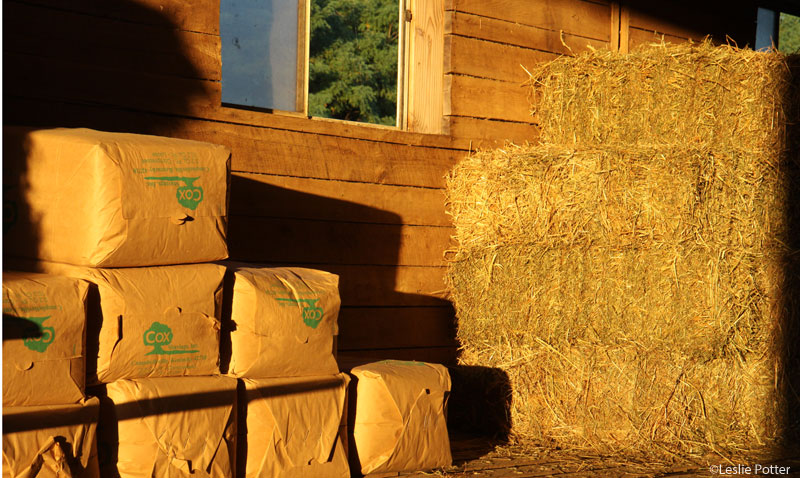
Be mindful of how and where you store hay, straw, bedding and other flammable stable supplies.
Convenience seems to be the uppermost consideration when it comes to where hay will be stored. As close to the horse as possible seems easiest, so most of us either store hay in a hayloft or in a stall, or in a hay area next to the horses. But looking at the nature of hay, convenient storage may not be the safest option for horses. However, there are ways to prevent a fire if there is no other option.
Keep air on the hay so that it remains dry,” Robert says. “Stack hay in rows of two bales with a half or quarter row separating them so that there is air circulation between the bales. If you have a bad bale, you’ll smell that musty odor sooner.”
Wired for Safety
Take a look at your daily habits and ask yourself if you are inadvertently creating a fire hazard. We all know the virtues of the “No Smoking” sign, but other human actions can have terrible consequences.
Portable space heaters can make a cold night of foal watch bearable; however, any portable heating or lighting device is dangerous. Wrap up warm instead. “I used to be on night watch in Kentucky at one of the big Thoroughbred farms and I was in a side guard shack,” Jenifer says. “I had my portable space heater on. All of a sudden a line of fire went from the cord to the wall. It was a good thing it wasn’t in the barn.” Only code-approved, permanently installed heaters should be in the barn.
“The number one cause of barn fires is electrical,” Jenifer says. “So have your electricity inspected once a year. Don’t overload fuses by using too many extension cords. People who show horses on the winter circuit will often rig up lights overhead to stop winter coats from growing. I have a picture of a barn that had an extension cord hanging right over the horse’s stall. It would have been so easy for the horse to chew on that cord and start a fire.”
While unplugging electrical devices when not in use, such as clippers and the radio, is a good idea, a better idea is to turn off the electricity when leaving the barn. If possible, have an outside switch that turns off all of the power to the barn.
Coil bucket heaters are another culprit. They are a big convenience when heating up water, but this is another area where complacency can set it. Never walk away from the heater. It’s too easy to get sidetracked on another task and forget it. “I can’t tell you how many bucket heaters have started a fire,” Robert says. “People put the heater in the water and go away for four or five hours. The coil burns right through the bucket and the barn burns down.”
Preventing rodents is very difficult in a barn, no matter how many cats you employ. Rodents not only create mess and carry diseases, but they also like to chew on the plastic around electrical cables. PVC and other plastics include salts in the production processes that are tasty to mice, so encase all wires in metal cable, ridged cable or EMT conduit. If you’re ever in doubt, get a qualified electrician’s advice.
Know the Drill
“I know a woman who owned a barn in the suburbs of Boston who had nine National Show Horses,” Robert says. “The woman was meticulous, just as clean as can be. She had an intercom in her house that linked to the barn. One evening she heard her horses in distress. She rushed to the barn and realized she had a fire. She couldn’t open the barn door, so she panicked and ran around in circles listening to her horses scream. All nine horses died, and the barn was rubble by morning. What happened is that she rushed down in a panic, and she kept trying to open the door from the hinge side.”
This horrible story is a clear illustration that even the most ordinary habits aren’t automatic when you’re in panic mode. This is why it is so important to know what your disaster plan will be and to practice it. “You have to be on automatic in a disaster,” Robert says. “This is why the military trains, police train, fire fighters train. You need to get muscle memory so that what you are doing is automatic.”
The first step in establishing a plan is map out the layout of your barn on paper: where the feed and hay are kept, where each horse stays and where the tack is. Next, note down exit routes that take you out of the barn and to where you will secure the horses. Simply turning them out of the barn or assuming they will leave on their own is out of the question. The notion that horses will run back or remain in a burning barn is sadly true. “Horses are used to their same stall, used to their same routine,” Robert says. “So if a stable turns into a fire scene the horse won’t leave it. He will stay in the barn and die. I’ve created a [mock] fire situation in a barn with smoke generators, and the horse went right back into the barn.”
Finally, include how wide the driveway is, where horses can be put and where the nearest source of water is—this can be a well, pond or a river. Also include emergency phone numbers (veterinarian, your numbers at work and at home) and a list of experienced local horse people who can help evacuate horses.
Distribute a copy to everyone who has anything to do with your barn or horses. Take a copy to your local fire station and keep another in a cylinder, marked “in case of emergency,” by your mailbox.
Post a large notice by your phone stating the location of your barn, including street names and any landmarks, which can be difficult to remember in an emergency. Also write the words boldly: In case of fire say to the operators, “I have a horse barn fire with living animals and not a storage barn fire.”
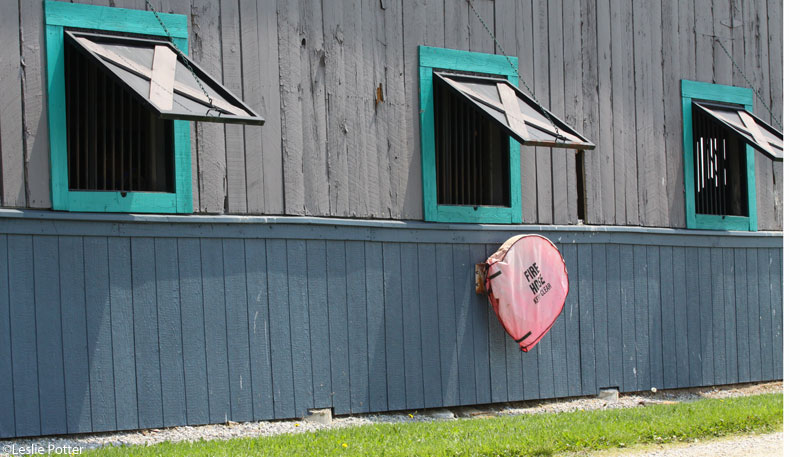
Make sure you have the right equipment in your barn, such as a phone, a flashlight and fire extinguisher (have them inspected yearly) at all exits. “Everyone who spends any time at your barn should know how to work the fire extinguisher,” Jenifer says. Leather halters and cotton lead ropes won’t get hot or melt like nylon will; always have them right by the horses at all times.
Put it into Practice
Here are some hints for an effective plan and how to practice.
- No matter what happens, never run down to the barn, always walk. Running takes blood away from the brain, and you need blood to help you keep a level head. “You also are working on a memory mode, so you must keep as calm as possible,” Robert says.
- First off, call the fire department. Obviously you’ll pretend to do this in your drill.
- If it is safe to do so, remove the horses. Gently coax each horse out of his stall. One at a time, the horse closest to the exit first, and safely tie them in your specified location. Remain calm and try to act as though everything is normal.
If a fire is small and can be put out with a fire extinguisher, this can be your next step. However, if the fire is any bigger, or you are at all uncertain, leave it to the fire fighters. “Black smoke is full of arsenic and cyanide,” Robert says. “You only need three of four breaths of that and you will die. People and horses don’t die from fire, they die from smoke inhalation.” Leave everything up to the fire department as much as possible. - Practice your drill. Time it and then study what you could have done more effectively. Run it where you have one person doing everything, then two people, then more.
You can ask your local fire department to come out and inspect your barn and advise ways to make your disaster program work better. And ask them if they will lead your horses out of the barns dressed in their fire gear as part of your practice drill. “We’ve gone to barns where horses have never seen fire trucks or fire fighters, and it didn’t take long for the horses to get used to that big old Martian coming at them. It’s good practice,” Robert says.
Fire prevention all goes back to neatness and awareness. Evaluate your barn and your habits, and note where you think a fire might start. Remove those fire hazards immediately, and make sure everyone who enters your barn understands that you are serious about fire.
More information on barn fire safety:
Fire Safety Equipment
Be Prepared for a Barn Fire
Stop a Barn Fire Before it Starts
Sharon Biggs is a dressage instructor and the author of In One Arena (Half Halt Press) and Advanced English Horsemanship (BowTie Press).



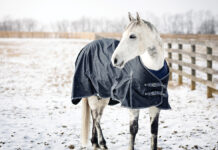
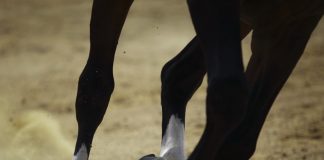

good to know.
Awesome Article. Great Practical Advice. Something we All should practice. Thank you.
Thank you for this article.. I picked up some valuable tips and we will start executing them tomorrow!
Great article, but I was wondering of the safety of heated water buckets in the winter?
Thank you
WAAAA, the stories are kindof scary, but they sure make us realize that our own barns arent indestructable.
will share with local fire department and trail riding club. will be good topic for meeting. thank you.
Wow, good article. I was considering buying heated buckets for the winter but I will pass unless I use them only when home and awake. Instead, I may go with a bucket cozy. See it here: wildangelcozy.com We had a cold winter last year and this year is supposed to be worse. I am interested in the salt for the hay since I had about 25-30 bales go bad during the year. I will stack them differently and try the salt because my hay IS with the horses, unfortunately.
Whenever I hear of a barn fire I shudder. So awful! I am thankful that my horses do not live in a barn.
good article!
I worry about fires all the time, but my horses are outside. Still I keep chickens, rabbits, and other animals in the barn for the winter. I do all the things mentioned above, but not the water hose, since we have no water in the barn, have to haul it from the house.
Excellent! Will post at current barn & my own new barn next spring. Xeroxing copies now. Like the idea of my VFD coming out in their turnouts; both my horses freak at even a new bush! And I wonder if any of the firemen would lead out a panicky horse? .Question: does it help or hinder covering the horses eyes to lead them out through smoke &/or fire…or is this a myth?